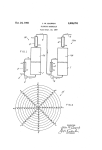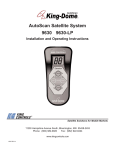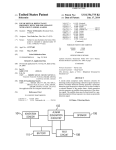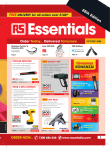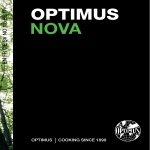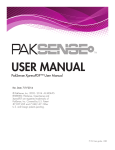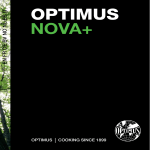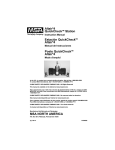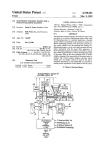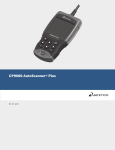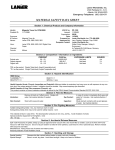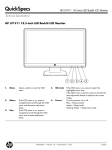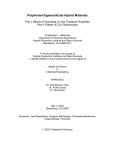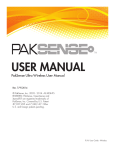Download Coding symbology and a method for printing same
Transcript
l|||||||||||||ll||l||||||||l|||||||||||||||||||||||||||||||||||||||||l|||||||||||||||||||| US 20030047616A1 (19) United States (12) Patent Application Publication (10) Pub. No.: US 2003/0047616 A1 Mase et al. (54) (43) Pub. Date: CODING SYMBOLOGY AND A METHOD Mar. 13, 2003 Related US. Application Data FOR PRINTING SAME (60) (76) Inventors: Joseph C. Mase, Chicago, IL (US); Margaret Trinidad, Spring Grove, IL (US); Scott Edwards, Libertyville, IL Provisional application No. 60/280,073, ?led on Mar. 30, 2001. Publication Classi?cation (Us) Correspondence Address: (51) (52) Int. Cl.7 .................................................. .. G06K 19/06 US. Cl. ............................................................ .. 235/494 Stephen R. Auten, Esq. Wallenstein & Wagner, Ltd. 53rd. Floor (57) ABSTRACT 311 S. Wacker Drive Chicago, IL 60606-6630 (US) (21) Appl, No; 10/075,153 The present invention provides forming a coding syrnbology by disposing a plurality of light-re?ecting segrnents sepa (22) Feb. 14, 2002 rated by spaces on a substrate. The coding syrnbology represents ?xed information and variable information. Filed: 30 Patent Application Publication Mar. 13, 2003 Sheet 1 0f 5 k a 4w n2,‘ 2__ L.) mi2 FIG. 1 US 2003/0047616 A1 Patent Application Publication Mar. 13, 2003 Sheet 2 0f 5 62 FIG. 2 US 2003/0047616 A1 Patent Application Publication Mar. 13, 2003 Sheet 3 0f 5 US 2003/0047616 A1 MM 1nd/a1; 72 /4 .I Z T FIG. 3 000U JW Patent Application Publication Mar. 13, 2003 Sheet 4 0f 5 US 2003/0047616 A1 BOTTOM EDGE X ‘\ TOP EDGE LASER APERTURE LASER BEAM PATH (@ 90° ABOVE BARC ODE) *H = 377 “HUMAN READABLE DATA”_______“TOP" SIDE ' BARCODE *NOTE.' H = BARCODE LABEL SURFACE TO LASER APERTURE SURFACE FIG. 4 Patent Application Publication Mar. 13, 2003 Sheet 5 0f 5 TOP Lil/Jill l MW [IHHH [[II I I / ' / 1/2’ // /7 ++300747118071Z HUMAN BEADABLE mm FIG. 5 US 2003/0047616 A1 Mar. 13, 2003 US 2003/0047616 A1 CODING SYMBOLOGY AND A METHOD FOR PRINTING SAME CROSS REFERENCE TO RELATED APPLICATION information Was translated into its corresponding analog counterpart. This tWo-color system naturally led to the development of a tWo-step process for printing the bar code. [0010] First, the container Was passed through a printing machine that applied a re?ective (generally White) back ground ?eld for the bar code. Next, the container Was passed through a second printing machine that applied the dark, [0001] This application claims priority to copending US. Provisional Application entitled “Coding Symbology and a Method for Printing Same”, having serial No. 60/280,073, ?led Mar. 30, 2001, Which is entirely encorporated herein by light-absorbing lines of the bar code over the top of the background ?eld. One common printing method Was the reference. hot-stamping (die-cast) system. [0002] This is a Utility Application of Provisional Appli [0011] In a hot-stamping system, a metal die is engraved in the desired image or bar code, heated to a predetermined temperature, and applied under pressure to the substrate in order to transfer the image or bar code from the hot-stamp foil. The foil acts as the pigment (ink) carrier and is fed cation No. 60/280073 ?led on Mar. 30, 2001. DESCRIPTION [0003] 1. Technical Field [0004] The present invention relates to a coding symbol ogy containing ?xed information and variable information, as Well as a method for transferring same. The invention is especially suitable for ?exible, transparent thermoplastic containers of liquid products that are commonly used in medical procedures. [0005] 2. Background of the Invention [0006] Various foodstuffs, liquids, and other substances can be sterilely packaged in pouch-type ?exible containers made from Webs of ?exible ?lm, sheet stock, or like material that is sealed together along the peripheral edges. There are a number of advantages to these pouch-type ?exible con tainers, including loW Weight, durability, and loW cost fab rication. [0007] Various medical solutions are sterilely packaged in pouch-type ?exible containers. The medical solutions can be pharmaceutical, ?ushes, nutrition, irrigating, respiratory therapy agents, dialysis, blood, blood products, plasma derivatives, plasma expanders, blood substitutes, anti-co agulants, blood preservatives, and the like. Such solutions can be delivered to a patient through an administration tubing set connected With the ?exible container. Other medical solutions include enterals, anesthesia inhalants, veterinarian, media, and the like. The container may include one or more access tubes or ?ttings through Which the liquid is pumped to ?ll initially the container during manufacture of the package and to Which the administration set and [0008] The use of bar coding to identify the contents of a container is Widespread in the medical industry. For example, bar code identi?cation systems alloW a hospital to track electronically its inventory of pharmaceutical prod ucts, and the subsequent billing to the patient for the use thereof. Bar codes are also used in automated agent com pounding systems to mix properly the correct and proper amounts of medical and therapeutic agents. More important, bar codes also alloW hospitals to monitor its medications or other therapeutic ?uids that are targeted for infusion into its patients by marking same With ?xed information such as product code names or numbers. [0009] Historically, a tWo-color system Was implemented in bar coding systems. That is, a typical bar code consisted of black lines on a White background. When a bar code reader Would read the bar code, the black lines Would absorb the reader’s laser light While the White spaces Would re?ect the reader’s laser light back to the reader Where the re?ected betWeen the hot-stamp die and the substrate. One problem is that the die has sharp edges that oftentimes damage the ?exible substrates heretofore mentioned, thus increasing the scrap rate. Still yet another problem is that the hot-stamp die is costly to produce, taking several hours, or even days, to manufacture. Accordingly, a hot-stamping system is unsuit able for printing images representative of variable informa tion such as lot numbers, batch numbers, expiration dates or any other data that changes in a ?xed time period, such as by the minute, hour, or day. [0012] Consequently, the hot-stamping system can be used to print feasibly only ?xed information such as a product’s name, manufacturer, and the like. One method of overcom ing this de?ciency is to print labels and apply them to the product. Naturally, this increases costs and decreases pro duction rates, as Well as opens the possibility for the label(s) to fall off of the product. [0013] Several other problems exist With the hot-stamping system as it relates to the readability of the bar codes on ?exible, transparent containers such as those commonly used in the medical industry. The ?rst problem With the readability of images printed by the hot-stamping system is that the transparent (light-absorbing) nature of the containers in such systems requires that a solid (light-re?ecting) back ground block be printed on the container before the dark (light-absorbing) lines of the bar code can be printed thereon. Not only is there the increased cost associated With tWo printing passes to achieve the tWo colors, but it is also fundamentally dif?cult to print a solid background block using the hot-stamping method because air pockets com monly form in the ink, Which cause voids in the block, resulting in an unreadable bar code. Additionally, because the background block naturally requires more pigment or ink than the contrasting bars, there is an increased risk for pigment extractives and leachables to exist in the container’s solution. [0014] Asecond problem is that because the hot-stamping system uses variable heat, variable pressure, and a ?xed dWell time to transfer images or bar codes onto the substrate, there is a problem of the ink bleeding or groWing too thick, Which causes an unreadable bar code or poor edge de?nition of the bar code symbology. To correct this problem, the dies have to be redesigned, re-machined, or re-engraved at a reduced siZe so that When applied, the correct bar code siZe is achieved. Alternatively, the siZe of the bar code symbol ogy, including bar spacing, could be increased if space limitations on the substrate so alloWed. Both solutions, Mar. 13, 2003 US 2003/0047616 A1 however, increase costs and decrease productivity. A third problem is that the inks in a hot-starnping system are designed to adhere to the underlying substrate, and not each other, further contributing to an unreadable bar code and rnandating the development of inks that adhere to each other. Fourth, hot-starnping typically yields a bar code With a “D” or “F” American National Standards Institute (ANSI) scale read (With “A” being the highest resolved image). See e.g, American National Standard for Information Systems—Bar Code Print Quality Guidelines, by The American National Standards Institute, @1990 by Information Technology Industry Council, and Which is incorporated by reference as though set forth herein. [0015] At least one attempt has been made to reduce the problems associated With a tWo-color, hot-starnping system, and is found in PCT patent application number PCT/US99/ 05614, bearing International Publication Number WO 99/49408, Which is incorporated herein by reference as though fully set forth herein. The ’408 application discloses a container bearing a negative image bar code generated using the above-described hot-starnping systern (page 8, a number of these thermal transfer systerns commercially available from different manufacturers such as SrnartDate® (MARKEM) and Jaguar J27i4 (NorWood Marking Sys terns). [0019] Still yet another bene?t of the thermal transfer printing system over the hot-starnping system is the ability to print srnaller bar codes that Will be accurately read. For example, the thermal transfer printing system requires on average approximately one-third to tWo-thirds of the length required for the hot-starnping system to print a code of a comparable syrnbol grade, depending on the substrate. In short, the thermal transfer printing system requires less space and provides superior bar code edge de?nition over the hot-starnping system. These advantages alloW one to print ?xed and variable information, including the label copy information, on pharmaceutical and medical agents, on either side, or both sides, of a container. Conversely, the siZe and resolution limitations of the hot-starnping rnethod force one to print ?xed information on one side of the container and variable information on the other side. These limitations add the manipulation of turning the container over and running a second printing pass, Which in turn, increases costs and decreases productivity. Accordingly, the thermal lines 22-24). The bar code is a negative image in that the light-re?ecting segments of the underlying substrate corre spond to the background spaces (generally White) of a traditional bar code, and the light-absorbing segments of the tirne efficiency, and bar code image resolution over the underlying substrate correspond to the light-absorbing dark segrnents (generally black) of a traditional bar code. hot-starnping systern. NotWithstanding, there still exists the problem of printing in a single pass a high resolution, [0016] Even prior thereto, the ability to print a negative one-color bar code that contains both ?xed information and variable information. transfer printing system affords irnproved cost ef?ciency, bar code irnage had been knoWn in the art as evidenced in the publication Barcodes and OtherAutomatic Identi?cation Systems, by Robert D. LaMoreaux at page 176, ©1995 by Pira International, Which is incorporated herein by reference as though fully set forth herein. NotWithstanding the advan tages of a one-color system, the remaining aforernentioned problems With the hot-starnping system still exist, including the inability to print ?xed and variable information in a single printing pass. [0020] The present invention is provided to solve these and other problems. SUMMARY OF THE INVENTION [0021] The present invention provides a novel identi?ca tion system and a method for employing the system. The identi?cation system can be used to control inventory, to [0017] Unlike the hot-starnping system, the thermal trans track a patient’s billing, to monitor particular dosages, to reduce potentially patient safety errors When used in corn fer printing systern uses a loW level of heat that transfers bination With other safety systems possibly not yet images (such as a bar code) from a printing head under light employed and those as described in US. Pat. Nos. 6,139, contact With the substrate. Because the bar code is not 495; 6,032,155; 5,845,264; and 5,700,998 Which are incor porated by reference as though fully set forth herein, and to printed under pressure, there is a superior bar code syrnbol ogy edge de?nition. That is, thermal transfer printing gen erally yields bar codes With an “A” or “B” ANSI scale read. Furthermore, the present inventors found that When an “A” quality code is printed using the thermal transfer system, the same code produces a “C” quality read through a 10 mil high-density polyethylene overpouch, the overpouch being Well-knoWn in the medical art. accomplish innurnerable other means and methods. [0022] The coding syrnbology of the present invention comprises a substrate and a plurality of light-re?ecting segrnents separated by spaces that are disposed on the substrate. The spaces on the substrate de?ne light-absorbing segrnents. Together, the light-re?ecting segments and the light-absorbing segrnents de?ne a negative image bar code [0018] Another bene?t of the thermal transfer printing system is that because the print head contains no sharp edges like the hot-starnp die, the print head does not damage the ?exible substrate, thus reducing the scrap rate. Another representing ?xed information and variable information. bene?t is that the thermal transfer printing system uses less pigrnent or ink that the hot-starnping system, resulting in a loWer risk of leachables or extractables in the container’s solution. Still another bene?t is that the thermal transfer presently knoWn, the details of which form no part of the present invention. In general, the bar code reader directs a printing head yields a higher degree of ?exibility than the hot-starnp die because the image information can be easily changed in a matter of minutes at an input terminal, as [0023] The present invention further provides that the coding syrnbology is detectable using a reader. It is under stood that a reader can be any form of a bar code reader form of energy on the image or bar code and receives all or a portion of the energy that is re?ected from the image or bar code. Preferably, the reader Will then translate the re?ected energy into a data form readily understood by humans. opposed to Waiting hours, or even days, for a hot-starnp die [0024] The present invention also provides that the light to be redesigned, re-rnachined, or even re-created. There are re?ecting segments are indicia that can be detected by a Mar. 13, 2003 US 2003/0047616 A1 reader, even though the indicia may or may not be visible to the naked human eye. That is, the light-re?ecting segments may exist at a Wavelength outside the visible light spectrum. It is known Within the art that bar codes could be ?uorescent, Which is outside the visible spectrum and is the subject of US. Pat. No. 5,547,501, Which is incorporated by reference as though fully set forth herein. In short, the present inven tion contemplates both visible and invisible coding sym bologies, or a combination thereof, provided that the re?ec tivity difference betWeen the light-re?ecting segments disposed on the substrate and the light-absorbing segments de?ned on the substrate enables the resulting image to be detected by a reader. If the indicia are visible to the naked human eye, the indicia can have a color Within the visible light spectrum. [0025] The substrate can be of any chemical composition, preferably comprising a thermoplastic polymer or a thermo set polymer, and even more preferably Where the substrate comprises a medical container. In another embodiment, tWo or more coding symbologies are disposed on a substrate Wherein the combination of the tWo or more codes repre sents ?xed and variable information. TWo or more codes could also be disposed Within a container system comprising at least one substrate forming a container and at least one material. One coding symbology or a plurality of symbolo gies could be disposed anyWhere in the container system. The present invention contemplates that the container sys tem comprises a substrate forming a medical container and a material forming an overpouch that covers at least a part of the substrate. [0026] The present invention also provides a method for transferring a negative image bar code onto a Web of material by ?rst providing a Web of material. The next step of the method is to provide a printer capable of transferring a negative image bar code onto the Web in response to a signal representative of the negative image bar code. According to the invention, the negative image bar code represents ?xed information and variable information. The negative bar code image is then transferred to the printer via the signal and transferred onto the Web of material. Prefer ably, the printer is a thermal transfer printer. The present method also contemplates that any predetermine number of negative image bar codes could be transferred in this man ner. [0027] Additional features and advantages of the present invention are described in, and Will be apparent from, the best mode for carrying out the invention. BRIEF DESCRIPTION OF THE DRAWINGS [0028] FIG. 1 is a fragmentary, perspective vieW of a coding symbology representing ?xed information and vari able information in a single, collective image transferred [0031] FIG. 4 illustrates the relative position of the Laser Scanner to the barcode in the comparative analysis. [0032] FIG. 5 shoWs an exemplary coding symbology produced by hot-stamp or thermal transfer methods. DETAILED DESCRIPTION OF THE PREFERRED EMBODIMENT [0033] While this invention is susceptible of embodiments in many different forms, and Will herein be described in detail, preferred embodiments of the invention are disclosed With the understanding that the present disclosure is to be considered as exempli?cations of the principles of the invention and are not intended to limit the broad aspects of the invention to the embodiments illustrated. [0034] FIG. 1 illustrates a negative image bar code image representing ?xed information and variable information that is transferred on a substrate. The bar code is designated generally by reference numeral 20. The bar code 20 includes a plurality of light-re?ecting segments 22 that are separated by spaces 24. The spaces 24 de?ne light-absorbing segments 26. The light-re?ecting segments 22 and light-absorbing segments 26 de?ne the negative image bar code 20 repre senting ?xed information and variable information. The bar code 20 and the light-re?ecting segments 26 are disposed on a substrate 30. [0035] The substrate 30 can be any knoWn chemical composition, including a thermoplastic or thermoset poly mer. Suitable thermoplastic and thermoset polymers are polyvinylchloride, polyvinyldichloride, polyole?ns, polya mides, polycarbonates, polyesters, thermoplastic elas tomers, elastomers, polyimides, polyurethanes, ethylene vinyl alcohol copolymers, ethylene vinyl acetate copoly mers, ethylene copolymers, propylene copolymers, acrylic acid copolymers, ethylene substituted acrylic acid copoly mers, ot-ole?n substituted acrylic acid copolymers, hydro carbon block polymers, ethylene propylene diene polymers, nylon, mono-layer ?lm structures, and multi-layer ?lm structures such as those disclosed in US. Pat. Nos. 6,168, 862; 6,083,587; 5,998,019; 5,993,949; 5,935,847; 5,693, 387; 5,686,527; 4,299,367; and 3,912,843, Which are incor porated by reference as though fully set forth herein. The ot-ole?n, Which preferably contains about 2 to 20 carbons, could be produced by any method knoWn generally. More particularly, the ot-ole?n is ethylene or propylene. [0036] Preferably, the substrate 30 is of a chemical com position such that the re?ectivity difference betWeen the substrate 30 and the light-re?ecting segments 22 alloWs the light-re?ecting segments 22 to form indicia (not shoWn) that can be detected by a reader (not shoWn). In terms of percent re?ectance, it is knoWn in the art that a preferred maximum re?ectance for the light-absorbing segments of a coding coding symbology representing ?xed information and vari symbology is about 25 percent, Which also corresponds to the preferred minimum re?ectance for the light-re?ecting segments. The maximum re?ectance of the light-absorbing segments and the minimum re?ectance of the light-re?ecting able information in at least tWo, collective images trans segments need not be achieved simultaneously. It is pre ferred onto a substrate. ferred that the overall pro?le re?ectance grade of the coding symbology permits the light-re?ecting segments, and more preferably the coding symbology, to be detected by a reader. onto a substrate. [0029] [0030] FIG. 2 is a fragmentary, perspective vieW of a FIG. 3 is a fragmentary vieW of a container system having a substrate With a coding symbology representing ?xed information and variable information, and a material [0037] The indicia of the light-re?ecting segments 22 may positioned over a portion of the coding symbology. not be visible to the naked human eye, or preferably, may be US 2003/0047616 A1 visible to the naked human eye so that the bar code 20 can be easily located and read by a bar code reader (not shown). The indicia of the light-re?ecting segments 22 may be colored White, red, yelloW, orange, gold, silver, or any combination thereof. The preferred color Will depend on the re?ective index of the chosen substrate and on the Wave length of energy used by the reader. As previously stated, it is understood that any color may be used provided that the re?ectivity difference betWeen the substrate 30 and the light-re?ecting segments 22 alloWs the light-re?ecting seg Mar. 13, 2003 chosen substrate and on the Wavelength of energy used by the reader. As previously stated, it is understood that any color may be used provided that the re?ectivity difference betWeen the substrate 60 and the light-re?ecting segments 42, and betWeen the substrate 60 and the light-re?ecting segments 52, alloW the light-re?ecting segments 42 and the light-re?ecting segments 52 to form a ?rst indicia (not shoWn) and a second indicia (not shoWn), respectively, that can be detected by a reader (not shoWn). ments 22 to form indicia (not shoWn) that can be detected by [0042] The present invention contemplates that any pre a reader (not shoWn). determined number of bar codes could be disposed on [0038] According to the invention, ?xed information is de?ned to be information that remains unchanged for a ?rst period of time While variable information is de?ned to be information that changes during the ?rst period. Examples of ?xed information include, but are not limited to, a product’s: name, code number, manufacturer, National Drug Code Number, label copy data required by the Federal Food & Drug Administration (FDA), or data required by the Health Industry Bar Code Council, noW knoWn as the Health Industry Business Communications Council (HIBCC), and the like. Examples of variable information include, but are not limited to, a product’s: lot number, batch number, expiration date, serial number, production time, price, inven substrate 60 by repeating this procedure. Additionally, it is also understood that substrate 60 could include a predeter mined number of symbologies like bar code 20 Where ?xed information and variable information are Within the same symbology. It is also understood that the coding symbolo gies disclosed herein may be used in conjunction With any current bar code symbologies including, but not limited to: Code 16K, Code 39, Code 49, Codabar, Code 128, UPC-E, UPC-A, EAN-8, BAN-13, Reduced Space Symbology (RSS), composite symbol, PDF-417, Interleaved 2-of-5 (ITF), as Well as tWo dimensional symbologies. It is further understood that either substrate 30 or substrate 60, alone or in combination, could be used to further de?ne a container tory control data, and concentration. Whole or in part. It is contemplated that the container could [0039] FIG. 2 shoWs another contemplated commercial as pharmaceutical, ?ushes, nutrition, irrigating, respiratory therapy agents, dialysis, blood, blood products, plasma derivatives, plasma expanders, blood substitutes, anti-co embodiment of the present invention and illustrates a frag mentary, perspective vieW of a coding symbology represent ing ?xed information and variable information in at least tWo, collective images. The coding symbology contains a ?rst bar code 40 representing ?xed information and a second bar code 50 representing variable information. The ?rst bar code 40 is de?ned, in part, by a ?rst plurality of light re?ecting segments 42 separated by spaces 44 and disposed on the substrate 60. The spaces 44 de?ne a ?rst set of light-absorbing segments 46, Which further de?ne the be a medical container used to store medical solutions such agulants, blood preservatives, and the like. It is also con templated that the container could be a pouch-type ?exible container. What is meant by ?exible is that the mechanical modulus of the container is less than or equal to 40,000 psi When measured according to ASTM D-882. [0043] As shoWn in FIG. 2, the substrate Would have an interior surface 64 opposed to an exterior surface 62 that remainder of the ?rst bar code 40. Would, in turn, de?ne the interior surface (not shoWn) and an exterior surface (not shoWn) of a container. The present [0040] The second bar code 50 represents variable infor mation. The second bar code 50 is de?ned, in part, by a invention contemplates that the ?rst bar code 40 or the second bar code 50 could be disposed on the interior surface 64 or the exterior surface 62, or both. Any predetermined number of symbologies could also be disposed on the interior surface 64 or the exterior surface 62, or both. It is second plurality of light-re?ecting segments 52 separated by spaces 54. The spaces 54 de?ne a second set of light absorbing segments 56, Which further de?ne the remainder of the second bar code 50. It is understood that the ?rst plurality of light-re?ecting segments 42 and second plurality of light-re?ecting segments 52 may be of the same chemical composition, although it is not necessary. In a preferred form of the invention, the ?rst plurality of light-re?ecting seg ments 42 and the second plurality of light-re?ecting seg ments 52 are a ?rst indicia (not shoWn) and a second indicia (not shoWn), respectively, that can be detected by a reader as heretofore described. The ?rst bar code 40 and the second bar code 60 are disposed on the substrate 60. [0041] As With the indicia related to the light-re?ecting segments 22 of the previous embodiment, the ?rst indicia and the second indicia of the present embodiment may not, or preferably may be, visible to the naked human eye. The ?rst indicia (not shoWn) of the ?rst plurality of light re?ecting segments 42 or the second indicia (not shoWn) of the second plurality of the light-re?ecting segments 52 may be colored White, red, yelloW, orange, gold, and silver. The preferred color Will depend on the re?ective index of the also contemplated that the ?rst bar code 40, the second bar code 50, or any predetermined number of bar codes (not shoWn) could be oriented in any manner, including by not limited to, adjacent, stacked, or overlapping. [0044] FIG. 3 is a fragmentary, perspective vieW of a container system having a substrate With a coding symbol ogy representing ?xed information and variable information, and a material positioned over a portion of the coding symbology. In one embodiment, there is a primary container, Which is referenced by number 80. The primary container 80 has a substrate 82 that may be of the same chemical composition as substrate 30 or substrate 60 previously described, although it is not necessary. Similar to the pre viously described embodiments, there is a plurality of light re?ecting segments 72 separated by spaces 74 and that are disposed on the substrate 82. The spaces 74 de?ne light absorbing segments 76. Together, the light-re?ecting seg ments 72 and the light-absorbing segments 74 de?ne a bar code 70 representing ?xed information and variable infor Mar. 13, 2003 US 2003/0047616 A1 mation. The substrate 82 de?nes an interior surface (not plurality of light-re?ecting segments, Which are separated by shown) and an opposed exterior surface 84 of the primary spaces, is disposed on the substrate. The unmolested area of container 80. the substrate beneath the light-re?ecting segments de?nes a [0045] As part of the container system, there also exists a material 92 positioned over a portion of the bar code 70, Wherein the bar code is detectable using a reader (not shoWn). The bar code 70 can be disposed anyWhere on the substrate 82 or even anyWhere on the material 92 provided that the bar code 70 is detectable using a reader (not shoWn). In accord With other embodiments disclosed herein, the present invention also contemplates any predetermined number of bar codes being disposed on the substrate 82, on the material 92, or both and containing ?xed information, variable information, or both. [0046] In another embodiment of the container system, the material 92 is a part or the Whole of an overpouch 90. The overpouch 90 may cover a portion or all of the primary container 80. Furthermore, the present invention contem plates that the primary container 80 may have at least one peripheral edge 86 that can be heat-sealed, radio-frequency sealed, or otherWise sealed using any knoWn technique the details of Which form no part of the present invention. The material 92 may also be developed into an overpouch 90 by sealing at least one peripheral edge 94 using any knoWn technique, the details of Which form no part of the present invention. second set of light-absorbing segments. Together, the second plurality of light-re?ecting segments and the second set of light-absorbing segments de?ne a second bar code. The present invention contemplates that any predetermined num ber of bar codes could be generated by this procedure. It is understood that When tWo or more bar codes are employed, the bar codes need not be disposed in physical contact With each other, adjacent to each other, or even on the same substrate, though such embodiments are contemplated. [0053] 3. Container Systems [0054] a. Primary Container With One Bar Code [0055] The present invention further provides that the substrate that forms a container may be used as a primary container Within a variety of container systems, Which are described herein. In one embodiment, there is a material positioned over a portion of the substrate, over a bar code located on the substrate, or both. The bar code is disposed on the substrate in a manner heretofore described, is detectable using a reader as heretofore described, and represents ?xed information and variable information as heretofore described. Further, the material in each of the container systems may be of the same chemical composition as the The substrate 82 may be made of any chemical substrate heretofore described, although it is not necessary composition provided that the re?ectivity difference betWeen the light-re?ecting segments 72 and the light ied in each of the container systems of the present invention, [0047] to carry out the invention. The primary container, as embod absorbing segments 74 de?ne a bar code 70 that is detectable may also be of the same chemical composition as the using a reader (not shoWn). Similarly, the material 92 may be of any knoWn chemical composition provided that if a bar code 70 Were disposed thereon, the re?ectivity difference substrate, or the material, or both, as heretofore described, although it is not necessary in order to carry out the invention. The present invention also provides that the betWeen the light-re?ecting segments 72 and the light material further comprises a secondary container such as an absorbing segments 74 Would alloW the bar code 70 to be overpouch and the like. detectable using a reader (not shoWn). Preferably, the sub strate 82 and the material 92 are of a chemical composition sufficient to Withstand the autoclaving process Without adhering to each other. [0048] It Will be understood that the invention may be [0056] It is understood that the primary container has an interior surface and an opposing exterior surface. Any pre determined number of bar codes could be disposed on the primary container’s interior surface, the exterior surface, or both, provided that a reader can detect each bar code. embodied in other speci?c forms, some of Which are set forth beloW, Without departing from the spirit or central characteristics thereof. The present examples and embodi ments, therefore, are to be considered in all respects as illustrative and not restrictive, and the invention is not to be limited to the details given herein. EXAMPLES [0049] 1. Coding Symbology With a Single Bar Code [0050] As stated above, the identi?cation system of the present invention provides a coding symbology disposed on [0057] As heretofore described, the light-re?ecting seg ments of this particular embodiment also are indicia that can be detected by a reader, and can be either visible or not visible to the naked human eye, or a combination thereof. If the light-re?ecting segments are embodied in the visible spectrum, they can be colored White, red, yelloW, orange, gold, and silver, or any color provided that, as heretofore described, the re?ectivity difference betWeen the light-re ?ecting segments disposed on the substrate and the light absorbing segments de?ned on the substrate alloWs the a substrate. The invention further provides that a plurality of light-re?ecting segments, and preferably the resulting light-re?ecting segments, Which are separated by spaces, is image, to be detected by a reader. disposed on the substrate. The unmolested area of the [0058] b. Primary Container With TWo or More Bar Codes absorbing segments. Together, the light-re?ecting segments [0059] In one particular embodiment, a primary container and the light-absorbing segments de?ne an image of a bar code. In a preferred form of the invention, the light-re?ect ing segments and the light-absorbing segments de?ne a negative image of a bar code. has a substrate, and the substrate has disposed thereon a ?rst bar code. The ?rst bar code is de?ned by a ?rst plurality of light-re?ecting segments that are on the substrate, and a ?rst set of light-absorbing segments that are de?ned by the [0051] Codes 2. Coding Symbology With TWo or More Bar spaces in the ?rst plurality. The ?rst bar code represents ?xed information, variable information, or both. [0052] When a second bar code is used, it is formed in the [0060] In the same embodiment, there exists a second bar code on the substrate of the primary container. The second substrate beneath the light-re?ecting segments de?nes light same general manner as the ?rst bar code. That is, a second Mar. 13, 2003 US 2003/0047616 A1 bar code is de?ned by a second plurality of light-re?ecting segments, and a second set of light-absorbing segments that are de?ned by the spaces in the second plurality. The second bar code represents ?xed information, variable information, or both. It is understood that the particular location of the ?rst bar code and second bar code on the substrate is not [0066] 4. Methods [0067] The present invention also provides a method for transferring a negative image bar code onto a Web of material. The ?rst step is to provide a Web of material. The Web can be of any knoWn chemical composition provided that When the negative image bar code is transferred thereon, the re?ectivity difference betWeen the negative image bar critical, provided that both codes remain detectable using a bar code reader. The present invention contemplates that any predetermined number of bar codes could be made using this procedure. As part of the container system, there also exists provide a printer capable of transferring a negative image a material, as heretofore described, that is positioned over a bar code on the Web in response to a signal representative of portion of either the ?rst bar code or the second bar code, or both. the negative image bar code having ?xed information and variable information. The signal may be generated by a [0061] Code c. Primary Container and Material Each With a Bar computer, softWare execution, a circuit, or any other knoWn methodology, the details of Which form no part of the present invention. The printer may be of any sort knoWn [0062] In yet another embodiment of the present inven generally, preferably a hot-stamp printer, a laser printer, an ink-jet printer, a ?exographic printer, or a thermal printer; tion, a ?rst bar code representing ?xed information or variable information is de?ned on a substrate that forms part or all of a primary container. The ?rst bar code is formed in the same general manner heretofore described. The substrate has an interior surface and an exterior surface upon Which the ?rst bar code could be disposed. This embodiment also provides for a material positioned over a portion of the substrate or the ?rst bar code, or both, as heretofore described. The material could further de?ne a secondary container such as an overpouch, a dustcover, and the like. [0063] The second bar code represents ?xed information or variable information, and is de?ned in the same general manner as described above. That is, the second bar code is de?ned by a second plurality of light-re?ecting segments separated by spaces and disposed thereon, and a second set of light-absorbing segments that are de?ned by the spaces of the second plurality. The material has a ?rst side adjacent to the primary container and a second side opposed to the ?rst side upon Which the second bar code, or any number of bar codes, could be disposed. The combination of the ?rst bar code and the second bar code represent both ?xed informa tion and variable information. As With any of the container systems described herein, tWo or more bar codes could be disposed on the substrate, or on the material, or both. [0064] Codes d. Material With One or With TWo or More Bar [0065] The present invention also provides another embodiments for a container system Wherein the substrate that forms a portion of the primary container has no bar code image disposed on it. Instead, the material as heretofore described has at least one bar code disposed on it. There may be a single bar code representing both ?xed information and variable information. In another embodiment, the substrate still contains no bar code, but the material has tWo or more bar codes disposed thereon. Each bar code represents ?xed information or variable information, or both. Additionally, the material has a ?rst side adjacent to the substrate and a second side opposed thereto upon Which any number of bar codes could be disposed. The exact location is not critical, provided that the bar code(s) are detectable by a reader. The bar codes are formed in the same general manner as here tofore described. If desired, the substrate could also contain any predetermined number of bar codes representing ?xed information or variable information, or both. code and the material is sufficient for the image to be detected using a reader. The next step of the method is to and more preferably a thermal transfer printer. [0068] The next step is transferring the signal to the printer and then transferring the negative image bar code onto the Web of material. The Web may be any thermoplastic polymer or a thermoset polymer previously described. As explained above, the exact chemical composition of the material is not critical provided that the re?ectivity difference betWeen the negative image bar code and the material is suf?cient for the negative image bar code to be detected using a reader. [0069] The negative image bar code can be transferred anyWhere on the Web, including on the Web’s interior or exterior surface. The present invention contemplates trans ferring the negative image bar code onto a Web of material that contains another bar code, such as a label copy bar code or even another negative image bar code. The Web can also form part or all of a container, or all or part of a material such as those used in the above-described container systems. The present invention also provides for transferring tWo or more negative image bar codes Where the negative image bar codes represent ?xed information, variable information, or both, individually or in combination. Comparative Analysis of Thermal Transfer Versus Hot Stamp Printing [0070] a. Background and Materials [0071] The quality and siZe of a thermal transfer printed barcode Was compared against a hot-stamp printed barcode. For purposes of this analysis, and as Will be explained in greater detail beloW, each barcode Was investigated as to Whether it Would decode upon scanning and produce an average ANSI letter grade of “B” or higher. Additionally, the inventors examined Whether each thermal transfer bar code could be decoded through a 1000 mL overpouch of high density polyethylene having a thickness de?ned beloW, and Which is commercially available from AtoFina Chemical & Oil under the Fina tradename, speci?cally Grade 7394. [0072] The veri?cation process employed in this compara tive analysis involved a precision instrument PSC Quick CheckTM 820 Laser/Mouse Compatible Barcode Veri?er (PSC, Inc., Webster, NY.) SN: 83987 that is designed to decode bar codes and to evaluate the symbol print quality against a published ANSI standard, namely ANSI X3182, Which is contained in ANSI’s Bar Code Print Quality Guideline, 1990 edition. The standard is outlined beloW. Mar. 13, 2003 US 2003/0047616 A1 [0083] Traceability: 3-16-67-134 [0073] Table 1 displays the tracking group identi?cation given to containers tested. Group A included 100 containers [0084] commercially available from Abbott Laboratories (Sterile Water for Injection, USP 2000 mL NDC 0074-7118-07) [0085] Where each container has a hot stamp barcode printed on the Batch No.: NC 8-31-00C76 Box 4 N=100 Sterile Water for Injection, USP 2000 mL NDC 0074-7118-07 backside of the bag (opposite of label copy). No additional redesign, sterility treatment or packaging etc. for Group A [0086] Jaguar J27-I4 Thermal Printer, SN: I4B0066 Was required or performed on the commercial embodiment. [0087] Group B included 300 containers commercially available from Baxter Healthcare Corporation knoWn as PD185 TC PSC Laser Scanner Model #: 4100+A3043 Via?ex® solution bag containers With each container having [0088] 6-mil aperture Mouse Wand (660 nm) a thermal transfer barcode printed on it. Table 1 also [0089] 10-mil aperture Mouse Wand (660 nm) speci?es that 60 containers from Group B Were designated [0090] N=1 Ruler ID: L12687 Calibration Exp: Apr. 6, 2002 to and enclosed in an overpouch of a predetermined thick ness. TABLE 1 Container Container Quantity overpouch Group Size Vendor N = Thickness ID A 2000 rnL Abbott 100 4.5 mil N/A N = 100 2 mil N = 60 4 mil N = 60 B 1000 rnL Baxter 300 6 mil Stock: 1133-12 Batch: RT 4-6-01 Box 1 Stock: 1133-11 Batch: RT 4-6-01 Box 1 Stock: 1133-10 Batch: N = 60 RT 4-6-01 Box 1 8 mil N=60 10 mil Stock: Batch: Stock: Batch: N=60 1133-9 RT 4-6-01 Box 1 1133-8 RT 4-6-01 Box 1 [0074] Other equipment used in this analysis includes: [0091] Digital Caliper ID: L8435 Calibration Exp: Mar. 30, 2002 [0075] Overpouches: (1000 mL) 100% Fina HDPE Grade—7394 [0076] 1 Roll 3M 810 Scotch®“MagicTM” Tape ID: 34-8506-4916-0 [0077] Barcodes 1 Roll Thermal Ribbon ID: TTR-71521 [0093] [0079] Stock No. 332116, data veri?ed against the human readable text, Which Was Batch No.: NC Oct. 14, 1999 C 15 Box 1. [0081] Cyclohexanone, Lot No.: 4872 T15641 Exp.: Dec. 6, 2001. [0082] Prior to printing the thermal transfer barcode onto the containers of Group B (Baxter), the barcode symbology of Group A (Abbott) Was ?rst identi?ed, and the encoded [0078] N=300 PVC Membrane Tubes, [0080] [0092] b. Printing of NormaliZed Thermal Transfer Bar codes and the Scanning of Pre-SteriliZed, Hot-Stamped N=300 PD185 TC Via?ex® 1000 mL dual port Containers: accomplished With the QuickCheckTM 820 Barcode Veri?er using the Laser Scanner. [0094] Table 2 identi?es the data encoded, format of the human readable data, and dimensional length/Width of the Abbott bar code (N=100). TABLE 2 Abbott Symbology Encoded Data Format Dimensions Type Data Chars Human Readable (Visual) X Y Code 128 0100300747118076 16 (01) 0 030074 711807 6 72 mm 12 mm (UCC/EAN) 98-4974-R2- 6/00 Mar. 13, 2003 US 2003/0047616 A1 [0095] Table 2 illustrates the symbology, data, number of characters, format, and dimensional length/Width of the direction. The scanner’s trigger Was released, and the scan ner’s position Was held such that the above-described scan Abbott barcodes. The Abbott barcode uses a version of Code ning position parameters Were not changed. 128 under the UCC/EAN standard. The data displayed under the “Encoded Data” column Was retrieved using the Laser Scanner of the Quick Check 820TM veri?er. [0103] The scanner’s trigger Was again depressed and held in order to decode and identify the symbology and encoded [0096] The dimensional Width Was measured using a calibrated ruler. [0097] data of the Group A barcode. The results of the scan Were recorded, and the above steps Were repeated to scan the remaining barcode samples of Group A. The trigger Was The “X” dimension (Length) Was measured depressed only When the scanner Was used to scan a barcode. from the outer side edge of one quiet Zone to the If an element of the scanning test environment Was changed (e.g., lighting), the scanner Was recalibrated as per above. outer side edge of the opposite quiet Zone using a calibrated ruler. [0098] The “Y” dimension (Height) Was measured from the top edge of the quiet Zone to the bottom edge of the same quiet Zone. [0099] The “Y” dimension (Height) had no analytical bearing on the testing procedures for this experi ment. [0100] The Abbott barcode Was replicated using the Jaguar Printer’s imaging softWare. Once the dimensional layout and identi?cation Was created, the image Was doWnloaded into the Jaguar handset. The thermal printer produced a barcode With the shortest element Width (total barcode element Width=total measured barcode length) of the same symbol ogy, number of encoded data characters, and miscellaneous text identi?ed in the Abbott barcode. The folloWing steps detail the manner in Which the Abbott barcode identi?cation process Was conducted: [0104] Table 3 shoWs the replication Abbott’s (Group A) barcode identi?cation onto Baxter’s (Group B) Via?ex® containers. [0105] The folloWing barcode element Width dimensions of N=150 barcodes produced an equivalent ANSI grade to that of the Abbott barcode. (See Table 8) [0106] X dimension: 22 mm Y dimension: 10 mm [0107] The folloWing barcode element Width dimensions of N=150 produced a better ANSI grade than that of the Abbott barcode. (See Table 8) [0108] X dimension: 52 mm Y dimension: 10 mm [0109] One barcode Was printed on 300 Via?ex® contain ers and placed inside a plastic bag. The barcodes Were printed at random Zones or regions of the containers. TABLE 3 Dimensions Symbology Encoded Data Format Type Data Chars Human Readable (Visual) Code 128 (UCC/EAN) 0100300747118076 16 (01) 0 030074 711807 6 98-4974-R2-6/00 [0101] The QuickCheckTM 820 Veri?er Was calibrated using the calibration standard bar code available inside the user manual (Quick-Check 600 Series User Manual, 2nd edition 1994 Part No QCOM600 available from PSC, Inc.) and then attached to the Laser Scanner (“scanner”). Before X Y (N = 150) (N = 150) 22 mm 52 mm 10 mm 10 mm [0110] c. ShadoW Test [0111] The “shadoW” test is a visual inspection test imple mented in the barcode veri?cation process in order to measure the integrity of the label to the substrate adhesion any scanning Was performed, the scanner Was held at a strength. The test employed Scotch® MagicTM Tape 810, distance of approximately a 3“ directly above the barcode. Which is available commercially from 3M and identi?ed above, Whereby the tape produces a shadoW of that barcode to Which it is applied. This shadoW is the result of the printer’s ribbon label adhering to the tape once it is applied and removed from the barcode. The quantitative amount of As shoWn in FIG. 4, the scanner Was oriented so that the top edge of the scanner is above the “top” side of the barcode and that the bottom edge of the scanner is above the “human readable data” side of the barcode. Also as shoWn in FIG. 4, the scanner’s aperture surface Was oriented to an approxi “shadoW” that is observed on the tape is then used to assess mately 90° angle above the barcode. the integrity of the barcode surface that Will survive abrasive [0102] contact or resist melting from extreme temperature condi The scanner’s trigger Was then depressed and held approximately the middle of the barcode, also shoWn in tions. An acceptable tape test result yielded less than approximately 50% of the ribbon label is transferred onto the tape. This test also helped visually assess any degrada tion of the barcode quality. The test Was performed imme diately folloWing the print production process and Was done only for the 300 Group B samples. Table 4 outlines the FIG. 5, by moving the scanner in a lateral or vertical results: to establish the correct scanning position. No data Was recorded on this scan. The laser beam emitted from the scanner’s aperture should cross the entire Width of the barcode, as is shoWn in FIG. 5. Without changing the angle or distance as speci?ed above, the laser beam Was moved to Mar. 13, 2003 US 2003/0047616 A1 printed barcodes. These samples Were tested after printing and prior to ?ll and pouching. TABLE 4 Baxter Sterilization Print Size: Phase: 22 mm x 10 mm 52 mm x 10 mm Pre Pre [0112] Sample Size: 0—50%: 150 150 51—100%: 150 150 [0117] e. Filling [0118] Table 6 shoWs the ?ll and air volume used for the Via?ex® (Group B) containers: 0 0 TABLE 6 The scotch tape Was applied to the barcode imme Container Size Solution Volume (mL) Air Volume Range (cc) 1000 mL 1050 mL 1 20 mL 55 cc 1 20 cc diately following the print. A small trace (0-50%) of the foil Was visible on the strip of tape for all prints. The scotch tape test result yielded less than 50% label transfer on the scotch tape, Which quali?ed it as an acceptable print. There Were no visible peel streaks created in any of the barcodes after the scotch tape Was removed from it. Table 4 re?ects data results generated for both Group B barcodes (1) 52 mm><10 mm and (2) 22 mm><10 mm. A sample size of 150 each Was taken from each group. [0113] d. Barcode Veri?cation Scanning: ANSI Grade Report (Pre-Sterilization) [0114] The ANSI Grade Report is an individual scan pro?le measurement report of the number of scans used to get a ?nal ANSI Symbol Grade. This report uses the Scan Pro?le methodology found in ANSI’s Bar Code Print Qual ity Guideline, Which is identi?ed above. The folloWing steps Were folloWed for the Via?ex® (Group B) containers. There Were no results reported for the Abbott (Group A) barcodes because the Abbott container pre-sterilization stage Was not applicable to this protocol. [0119] All 300 containers Were ?lled using the speci?ca tions listed above in Table 1. [0120] f. Overpouch Assembly and Sterilization Cycles [0121] the lengths of 131/z“><61/z“ (Refer to Table 1 for thickness of individual stock rolls). The ?lm Was then sealed manually using the Vertrod sealer. No defects Were observed in the overpouch material. The containers Were loaded inside the overpouch and then sealed. The samples Were loaded on the sterilization trays With the barcode print facing up, Whereby the barcode Was not in direct contact With the tray. A sterilization cycle Was then performed according to Speci ?cation 14-04-01-119 Cycle No. 04-026 at the maximum time and temperature conditions (i.e, 56.0 minutes at 252° [0122] [0115] First, a 6-mil aperture mouse Wand Was attached to the Scanner. Second, the Quick Check 820 scanner Was All 300 Group B containers Were transferred to the Vertrod Sealer. A stock roll of 100% HDPE ?lm Was cut to g. Barcode Veri?cation Scanning: Decode on Scan (Post-Sterilization) TABLE 7 calibrated (as set forth earlier) prior to scanning the barcode for identi?cation. The Quick Check Veri?er Was then con ?gured to achieve 10 scans per barcode for extended accu racy. Each individual scan of the 10 averaged by the Scanner Was recorded during scanning. The Scanner then reported each scan grade as an alpha character. Each barcode on the 300 Group B containers Was scanned by rolling the mouse Wand over and across the middle of the barcode. Table 5 Samples N Read on Scan Sterilization GROUP # Pass Fail Pre Post Baxter Abbott 300 100 300 100 0 0 N/A N/A 300 300 details the results. [0123] Table 7 shoWs that all barcodes Were able to be decoded upon scanning. All 300 barcodes on the Via?ex® TABLE 5 (Group B) containers and all 100 barcodes on the (Group A) ANSI Grade (Pre-Sterilization) - Results: Baxter Group B - 6 mil Mouse Wand Print Sterilization Sample Average Abbott containers Were decoded through their respective Dimensions overpouches With the Laser Scanner using scanning proce dures detailed above. A maximum of 10 scan attempts Were Method: Phase: Size: Scan Pass: Grade: X Y Thermal Pre- 150 10 C 22 mm 10 mm each individual units Was not recorded. Only an observa tional note Would be recorded for units failing to decode, of Transfer Thermal performed. The number of scans actually required to decode Pre- 150 10 B 52 mm 10 mm Which there Were none. Transfer [0124] In some cases, Water droplets Were visible inside in the Baxter (Group B) overpouch as a result of recent [0116] Table 5 indicates that the total average ANSI grade produced through thermal transfer print yielded a “C” out of a sample size of 150 (22 mm><10 mm barcodes) and a grade of “B” out of a sample size of 150 (52mm><10 mm barcodes). The sum or total average is the average of each individual sample scan average after a scan pass of 10. A6-mil aperture mouse Wand Was used to test the grade for the thermal sterilization. The overpouch Was then pressed against the primary container ?lm surface to disperse or remove the Water droplets. Human hands Were used to smooth aWay Wrinkles that Were present in the overpouch. The Abbott overpouches Were observed to be completely dry. No over pouches needed to be removed for any barcode to be decoded. Mar. 13, 2003 US 2003/0047616 A1 [0125] h. Barcode Veri?cation Scanning: ANSI Grade results. A Laser Scanner Was used to scan the hot stamp barcodes. A scan using a 6-mil aperture or 10-mil aperture mouse Wand aperture Was not Report (Post-Sterilization) [0126] For each of the 400 samples in Groups A and B, the achievable When testing the hot stamp barcode. respective overpouch Was removed, the port tubes Were cut off using scissors, and the samples Were completely drained TABLE 9 of all ?uid. The scanning procedures detailed above Were then employed for scanning each barcode and generating an ANSI grade report. The 300 Via?ex® samples Were scanned using the 6-mil aperture mouse Wand. The 100 Abbott samples could not be scanned using the 6-mil aperture or 10-mil aperture mouse Wand. Instead, the Laser Scanner Was used. One inherent difference betWeen the mouse Wand and Laser Scanner is that the mouse Wand provides a re?ectance grade Where the Laser Scanner does not. This information may be used as a supplemental analytical tool guide to assess the quality of the barcode print in a pre-production print quality control veri?cation process. [0127] Next, a 15 square inch piece from each overpouch used to pouch the 300 Via?ex® samples Was cut and pressed ?rmly over the barcode for scanning the barcode through the cut overpouch section. Human ?ngers Were used to smooth ANSI Grade (Post-Sterilization)‘ In Pouch — Results: Print Sample Scan Method: Sterilization: Size: Pass: Pouch Thickness (mils): Average Grade: Baxter — 22 mm x 10 mm Barcode (Laser Scanner) Thermal Thermal Thermal Thermal Thermal Post Post Post Post Post 21 21 21 21 21 1O 1O 1O 1O 1O 2 4 6 8 10 C C C C C Baxter — 22 mm x 10 mm Barcode (Mouse Wand) Thermal Thermal Thermal Thermal Thermal Post Post Post Post Post 21 21 21 21 21 1O 1O 1O 1O 1O 2 4 6 8 10 C C C C C Pouch Thickness (mils): Average Grade: out any Wrinkles that Were present The same scanning procedures detailed above Were used to scan the barcode through the overpouch and generate an ANSI grade report. [0133] All scans through an overpouch Were achieved using the 6-mil aperture mouse Wand. This same procedure Was TABLE 10 repeated for the 100 Abbott barcodes except that the Laser Scanner Was used instead of the 6-mil Wand. Further, the Group B barcodes Were rescanned using the Laser Scanner to validate that the mouse Wand and Laser Scanner could achieve the same end results. The folloWing tables and graphs illustrate the results. TABLE 8 Print Sample Scan Method: Sterilization: Size: Pass: Baxter - 52 mm x 10 mm Barcode (Laser Scanner) Thermal Thermal Thermal Thermal Thermal Sterili Sample Scan Average Dimensions Group: Phase: Size: Pass: Grade: X Y Baxter Baxter Abbott Post Post Post 150 150 100 10 10 10 C B C 22 mm 52 mm 72 mm 10 mm 10 mm 12 mm [0128] = 150 150 100 Thermal Thermal Thermal Thermal Thermal Post Post Post Post Post 2 4 6 8 10 B B B B B Print Method: Sterilization: their respective pouches. These samples Were tested after Hot Stamp Post The thermal transfer print yielded an average ANSI grade “C” out of a sample size of 150 for the 22 mm><10 mm Baxter barcode and an average ANSI grade of “B” for the 52 mm><10 mm Baxter barcode. A 6-mil aperture mouse Wand Was used to test the grade for the thermal printed barcodes. In addition, a Laser Scanner Was used and yielded the same results. [0131] Hot Stamp (Group A): 1O 1O 1O 1O 1O 2 4 6 8 10 B B B B B Abbott — 72 mm x 12 mm Barcode (Laser Scanner) sum or total average grade is the average of each individual sample average after a 10 scan passes. The above tables also re?ect the average ANSI Grade of the barcodes tested out of printing and after ?lling and pouching. [0129] Thermal Transfer Barcodes (Group B): 21 21 21 21 21 TABLE 11 Table 8 indicates that the total average ANSI grade [0132] 1O 1O 1O 1O 1O [0134] produced through thermal transfer print and hot stamp. The [0130] 21 21 21 21 21 Baxter — 52 mm x 10 mm Barcode (Mouse Wand) ANSI Grade Post-Sterilization ; Out of Pouch — Results: zation Post Post Post Post Post Sample Scan Size: Pass: 42 10 Pouch Thickness (mils): Average Grade: 4.5 C [0135] Table 9 indicates that the total average ANSI grade of “C” Was yielded for 42 (21 Laser Scanner+21 Mouse Wand) 22 mm><10 mm Baxter barcode samples. Table 10 indicates that the total average ANSI grade of “B” Was yielded for 42 (21 Laser Scanner+21 Mouse Wand) 52 mm><10 mm Baxter barcode samples. Table 11 also re?ects the average ANSI Grade of the 42 (Laser Scanner) hot stamp (Abbott) barcodes tested through their respective pouches yielded a “C”. The sum or total average is the average of The hot stamp print yielded an average ANSI each individual sample average after 10 scan passes. A 6-mil grade “C” out of a sample size of 100 in both table aperture mouse Wand and a Laser Scanner Were used to test Mar. 13, 2003 US 2003/0047616 A1 the grade for the thermal (Baxter) barcodes. Via?ex® sample numbers 130-150 of each Baxter barcode dimension 8. The coding symbology of claim 1 Wherein the variable information is select ed from the group consisting of lot size Were used to test the print quality through the various overpouches thickness. These samples Were tested after number, batch number, expiration date, serial number, pro duction time, price, inventory control data, and concentra printing and after ?ll and pouching. tion. [0136] The above shoW that the thermal transfer print process Was able to reduce the Abbott barcode image siZe (Width) by approximately 69% and produce an equal ANSI Grade Average of “C” both out of pouch and in pouch. In the second part of this experiment, the thermal transfer print process Was able to reduce the Abbott barcode image siZe (Width) by 28% and produce an average grade of “B” both out of pouch and in pouch, Whereby the Abbott barcode only reported an ANSI Grade Average read of “C” (out of pouch). The thermal transfer print process alloWed for ?exibility of desired barcode image print dimensions through the control of softWare. The barcode image quality Was veri?ed under the process of Barcode Print Veri?cation. The veri?cation process required that the Group A and Group B barcodes could be scanned and barcodes, illustrates that the image quality of the barcodes produced by thermal transfer requires a lesser need for reprinting bad barcodes based upon the higher quality of print that it produces. [0137] It Will be understood that the invention may be embodied in other speci?c forms Without departing from the spirit or central characteristics thereof. The present examples and embodiments, therefore, are to be considered in all respects as illustrative and not restrictive, and the invention is not to be limited to the details given herein. We claim: 1. A coding symbology comprising: 9. The coding symbology of claim 1 Wherein the coding symbology is disposed on a medical container. 10. The coding symbology of claim 1 Wherein the sub strate comprises a thermoplastic polymer or a thermoset polymer. 11. The coding symbology of claim 1 Wherein the ther moplastic polymer or the thermoset polymer is selected from the group consisting of polyvinylchloride, polyvinyldichlo ride, polyole?ns, polyamides, polycarbonates, polyesters, thermoplastic elastomers, elastomers, polyimides, polyure thanes, ethylene vinyl alcohol copolymers, ethylene vinyl acetate copolymers, ethylene copolymers, propylene copolymers, acrylic acid copolymers, ethylene substituted acrylic acid copolymers, ot-ole?n substituted acrylic acid copolymers, hydrocarbon block polymers, ethylene propy lene diene polymers, nylon, mono-layer ?lm structures and multi-layer ?lm structures. 12. The coding symbology of claim 11 Wherein the polyole?n is produced from an ot-ole?n having from about 2 to about 20 carbons. 13. The coding symbology of claim 12 Wherein the ot-ole?n is ethylene or propylene. 14. A container having a coding symbology comprising: a substrate; a plurality of light-re?ecting segments separated by a substrate; spaces and disposed on the substrate, the spaces de?n a plurality of light-re?ecting segments separated by ing light-absorbing segments; spaces and disposed on the substrate, the spaces de?n ing light-absorbing segments; Wherein the light-re?ecting segments and the light-ab sorbing segments de?ne a negative image bar code representing ?xed information and variable informa tion; and Wherein the coding symbology is detectable using a reader. 2. The coding symbology of claim 1 Wherein the light re?ecting segments are indicia that can be detected by a reader. 3. The coding symbology of claim 2 Wherein the indicia Wherein the light-re?ecting segments and the light-ab sorbing segments de?ne a negative image bar code representing ?xed information and variable informa tion; Wherein the coding symbology is detectable using a reader; and Wherein the substrate comprises a pouch-type ?exible container. 15. A coding symbology comprising: a substrate; is visible to the naked human eye. 4. The coding symbology of claim 3 Wherein the indicia has a color selected from the group consisting of White, red, yelloW, orange, gold, and silver. 5. The coding symbology of claim 3 Wherein the indicia is not visible to the naked human eye. 6. The coding symbology of claim 1 Wherein the ?xed information remains unchanged for a ?rst period of time While the variable information changes during the ?rst period. 7. The coding symbology of claim 1 Wherein the ?xed information is selected from the group consisting of product name, product manufacturer, Universal Product Code, Uni versal Product Number, National Drug Code, National Health Related Industry Code, and label copy data. a ?rst plurality of light-re?ecting segments separated by spaces and disposed on the substrate, the spaces de?n ing a ?rst set of light-absorbing segments, and Wherein the ?rst plurality and the ?rst set de?ne a ?rst bar code representing ?xed information; a second plurality of light-re?ecting segments separated by spaces and disposed on the substrate, the spaces de?ning a second set of light-absorbing segments, Wherein the second plurality and the second set de?ne a second bar code representing variable information; and Wherein the coding symbology is detectable using a reader. Mar. 13, 2003 US 2003/0047616 A1 12 16. A container having a coding symbology comprising: 20. A container system comprising: a substrate de?ning a portion of the container; a primary container having substrate; a plurality of light-re?ecting segments separated by a ?rst plurality of light-re?ecting segments separated by spaces and disposed on the substrate, the spaces de?n ing light-absorbing segments; Wherein the light-re?ecting segments and the light-ab sorbing segments de?ne a negative image bar code representing ?xed information and variable informa spaces and disposed on the substrate, the spaces de?n ing a ?rst set of light-absorbing segments, and Wherein the ?rst plurality and the ?rst set de?ne a ?rst bar code representing ?Xed information or variable information; a material positioned over a portion of substrate; tion; Wherein the negative image bar code is detectable using a reader; and Wherein the container is a medical container. 17. A container comprising: a substrate; a ?rst plurality of light-re?ecting segments separated by spaces and disposed on the substrate, the spaces de?n ing a ?rst set of light-absorbing segments, and Wherein the ?rst plurality and the ?rst set de?ne a ?rst bar code representing ?Xed information; a second plurality of light-re?ecting segments separated by spaces and disposed on the material, the spaces de?ning a second set of light-absorbing segments, and Wherein the second plurality and the second set de?ne a second bar code representing ?Xed information or variable information; Wherein the ?rst bar code and the second bar code are detectable using a reader; and Wherein the combination of the ?rst bar code and the second bar code represent ?Xed information and vari able information. 21. A container system comprising: a second plurality of light-re?ecting segments separated by spaces and disposed on the substrate, the spaces de?ning a second set of light-absorbing segments, and Wherein the second plurality and the second set de?ne a second bar code representing variable information; Wherein the ?rst bar code and second bar code are detectable using a reader; and a primary container having a substrate; a material positioned over a portion of the substrate; a plurality of light-re?ecting segments separated by spaces and disposed on the material, the spaces de?n ing light-absorbing segments, and Wherein the light re?ecting segments and the light-absorbing segments Wherein the container is a medical container. de?ne a bar code representing ?Xed information and 18. A container system comprising: variable information; and a primary container having a substrate; a plurality of light-re?ecting segments separated by Wherein the bar code is detectable using a reader. 22. A container system comprising: spaces and disposed on the substrate, Wherein the a primary container having substrate; spaces de?ne light-absorbing segments, Wherein the light-re?ecting segments and the light-absorbing seg a material positioned over a portion of the substrate; ments de?ne a bar code representing ?Xed information a ?rst plurality of light-re?ecting segments separated by and variable information, and Wherein the bar code is detectable using a reader; and a material positioned over a portion of the substrate. 19. A container system comprising: a primary container having substrate; a ?rst plurality of light-re?ecting segments separated by spaces and disposed on the substrate, the spaces de?n ing a ?rst set of light-absorbing segments, and Wherein the ?rst plurality and the ?rst set de?ne a ?rst bar code representing ?Xed information; a second plurality of light-re?ecting segments separated by spaces and disposed on the substrate, the spaces de?ning a second set of light-absorbing segments, and Wherein the second plurality and the second set de?ne a second bar code representing variable information; Wherein the ?rst bar code and the second bar code are detectable using a reader; and a material positioned over a portion of the substrate. spaces and disposed on the material, the spaces de?n ing a ?rst set of light-absorbing segments, and Wherein the ?rst plurality and the ?rst set de?ne a ?rst bar code representing ?Xed information; a second plurality of light-re?ecting segments separated by spaces and disposed on the material, the spaces de?ning a second set of light-absorbing segments, and Wherein the second plurality and the second set de?ne a second bar code representing variable information; Wherein the ?rst bar code and the second bar code are detectable using a reader. 23. A method of transferring a negative image bar code onto a Web of material comprising the steps of: providing a Web of material; providing a printer capable of transferring a negative image bar code onto the Web in response to a signal representative of the negative image bar code, the negative image bar code representing ?Xed information and variable information; and Mar. 13, 2003 US 2003/0047616 A1 13 transferring the signal to the printer; and 29. A container system comprising: transferring the negative image bar code onto the Web of a primary container having a substrate; material. 24. The method of claim 23 Wherein the printer is a thermal transfer printer. 25. A container system comprising: a primary container having a substrate; a material positioned over a portion of the substrate; Wherein the container system has a negative image bar code representing ?xed information and variable infor mation, and Wherein the negative image bar code is detectable using a reader. 26. The container system of claim 25 Wherein the negative image bar code is disposed on the primary container. 27. The container system of claim 25 Wherein the negative image bar code is disposed on the material. 28. The container system of claim 25 Wherein the material is positioned over a portion of the negative image bar code. a material positioned over a portion of the substrate; Wherein the container system has a ?rst negative image bar code representing ?xed information and a second negative image bar code representing variable infor mation, and Wherein the ?rst and second negative image bar codes are detectable using a reader. 30. The container system of claim 29 Wherein the ?rst and second negative image bar codes are disposed on the pri mary container. 31. The container system of claim 29 Wherein the ?rst and second negative image bar codes are disposed on the mate rial. 32. The container system of claim 29 Wherein the ?rst negative image bar code is disposed on the primary con tainer and the second negative image bar code is disposed on the material.



















